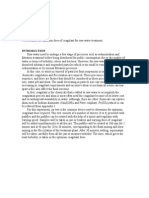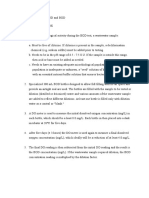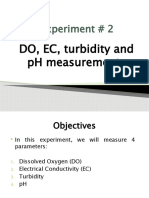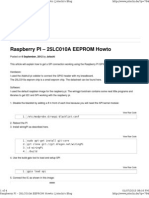Bacteria Count Labsheet
Uploaded by
Abby FaizBacteria Count Labsheet
Uploaded by
Abby FaizFACULTY OF CIVIL AND ENVIRONMENTAL ENGINEERING DEPARTMENT OF WATER RESOURCES AND ENVIRONMENTAL ENGINEERING ENVIRONMENTAL ENGINEERING LABORATORY
LABORATORY INSTRUCTION SHEETS
SUBJECT CODE EXPERIMENT CODE EXPERIMENT TITTLE COURSE CODE
BFC3121 MA2 BACTERIA COUNT
KOD ETIKA PELAJAR (KEP)
JAB. KEJ. SUMBER AIR & ALAM SEKITAR FAKULTI KEJURUTERAAN AWAM & ALAM SEKITAR KUiTTHO
Saya dengan ini mengaku bahawa saya telah menyediakan laporan ini dengan daya usaha saya sendiri. Saya juga mengaku tidak menerima atau memberi sebarang bantuan dalam menyediakan laporan ini dan membuat ikrar ini dengan kepercayaan bahawa apaapa yang tersebut di dalamnya adalah benar.
___________________________ Tandatangan Pelajar Nama : _______________________________ No. Matrik :____________________________ Tarikh :________________________________
FACULTY OF CIVIL & ENVIRONMENTAL ENGINEERING DEPARTMENT OF WATER RESOURCES AND ENVIRONMENTAL ENGINEERING ENVIRONMENTAL ENGINEERING LABORATORY
SHORT REPORT
SUBJECT CODE CODE & EXPERIMENT TITLE COURSE CODE EXPERIMENT DATE NAME OF STUDENT NO.OF GROUP GROUP MEMBER 1. 2. 3. 4. 5. NAME OF LECTURER/INSTRUCTOR/ TUTOR DATE OF REPORT ACCEPTANCE MARKS DICIPLINE/ PARTICIPITATION RESULTS DATA ANALYSIS DISCUSSION TOTAL EXAMINERS COMMENT /25% /30% /30% /100% /15%
APPROVAL RECEIVE
FACULTY : CIVIL & ENVIRONMENTAL ENGINEERING DEPT : WATER RESOURCE & ENVIRONMENTAL ENGINEERING LAB : ENVIRONMENTAL ENGINEERING
PAGE NO.: EDITION: REVISION NO.: EFFECTIVE DATE:
1/5 MA2 03 01/12/2007 20/11/2007
EXPERIMENT : BACTERIA COUNT
AMMEND. DATE:
1.0 OBJECTIVE Students will be able to measure the bacteriological quality of water sample by performing total plate count.
2.0 LEARNING OUTCOMES At the end of the laboratory courses, students will be able 1. Become proficient at dilutions. 2. Become proficient at performing a standard plate count and determining bacterial counts in a sample. 3.0 THEORY Bacteria are remarkably adaptable to diverse environmental conditions: they are found in the bodies of all living organisms and on all parts of the earthin land terrains and ocean depths, in arctic ice and glaciers, in hot springs, and even in the stratosphere. Our understanding of bacteria and their metabolic processes has been expanded by the discovery of species that can live only deep below the earth's surface and by species that thrive without sunlight or in the high temperature and pressure near hydrothermal vents on the ocean floor. There are more bacteria, as separate individuals, than any other type of organism; there can be as many as 2.5 billion bacteria in one gram of fertile soil. Many studies require the quantitative determination of bacterial populations. The two most widely used methods for determining bacterial numbers are the standard, or viable, plate count method and spectrophotometric (turbidimetric) analysis. Although the two methods are somewhat similar in the results they yield, there are distinct differences. For example, the standard plate count method is an indirect measurement of cell density and reveals information related only to live bacteria. The spectrophotometric analysis is based on turbidity and indirectly measures all bacteria (cell biomass), dead and alive. The standard plate count method consists of diluting a sample with sterile saline or phosphate buffer diluent until the bacteria are dilute enough to count accurately. That is, the final plates in the series should have between 30 and 300 colonies. Fewer than 30 colonies are not acceptable for statistical reasons (too few may not be representative of the sample), and more than 300 colonies on a plate are likely to produce colonies too close to each other to be distinguished as distinct colony-forming units (CFUs). The assumption is that each viable bacterial cell is separate from all others and will develop into a single discrete colony (CFU). Thus, the number of colonies should give the number of bacteria that can grow under the incubation conditions employed. A wide series of -4 -10 dilutions (e.g., 10 to 10 ) is normally plated because the exact number of bacteria is usually unknown. Greater accuracy is achieved by plating duplicates or triplicates of each dilution. Increased turbidity in a culture is another index of bacterial growth and cell numbers (biomass). By using a spectrophotometer, the amount of transmitted light decreases as the cell population increases. The transmitted light is converted to electrical energy, and this is indicated on a galvanometer. The reading, called absorbance or optical density, indirectly reflects the number of bacteria. This method is faster than the standard plate count but is limited because 7 sensitivity is restricted to bacterial suspensions of 10 cells or greater.
PREPARED BY: BALKIS A. TALIP
SIGNATURE: DATE: 20 NOVEMBER 2007
FACULTY : CIVIL & ENVIRONMENTAL ENGINEERING DEPT : WATER RESOURCE & ENVIRONMENTAL ENGINEERING LAB : ENVIRONMENTAL ENGINEERING EXPERIMENT : BACTERIA COUNT
PAGE NO.: EDITION: REVISION NO.: EFFECTIVE DATE: AMMEND. DATE:
2/5 MA2 03 01/12/2007 20/11/2007
4.0 EQUIPMENTS & MATERIALS 1. 2. 3. 4. 5. 6. 7. 8. 9. 10. Petri plate Pipette Test tube Glass rod Bunsen burner Incubator Ethanol 95% @ methanol Sterilizer Microscope Bacteria medium: Peptone = 5g, Beef Extract=3g, Agar=15g, Distilled water=600 mL
5.0 PROCEDURES 5.1 Media preparation: Please prepare the nutrient media using the microbiology standard method.
5.2 Sample preparation: Prepare the serial dilution of the water sample using the appropriate
dilution factor.
5.3 Plating procedures: Using the pour plate and spread plate method.
FACULTY : CIVIL & ENVIRONMENTAL ENGINEERING DEPT : WATER RESOURCE & ENVIRONMENTAL ENGINEERING LAB : ENVIRONMENTAL ENGINEERING EXPERIMENT : BACTERIA COUNT
PAGE NO.: EDITION: REVISION NO.: EFFECTIVE DATE: AMMEND. DATE:
4/5 MA2 03 01/12/2005 20/12/2005
6.0 RESULTS & CALCULATIONS / ANALYSIS
Plating Method Pour Plate Spread Plate
Average Colony/plate 119 125
Dilution 1/10 190 200 1/100 175 180 1/1000 155 160 1/10 85 90
4
1/10 75 80
1/10 35 40
Total bacteria / mL
7.0 DATA ANALYSIS
1.
Show the calculation for each of the plating method and fill in the above table.
2.
Analyze the results by using the appropriate method. Explain your findings.
3.
State the systematic bias error that could occur during this experiment.
4.
Usually, the result shows different reading for both methods. However, in some cases, both methods produce the same result. Explain why the results are indistinguishable.
8.0 QUESTIONS Explain the meaning of phrases two times ten to the eight cells per mL in your own convenient terminology.
1.
2.
What the meaning of TNTC and the significant amount due to the TNTC? Give the formula for determining bacteria count
3.
Design the experiment for comparing the bacteria counts of water sample (tapwater, lake water, swimming pool water and rainbarrel water). Explain the different of bacteria count for each type of water sample?
4.
In many experiment there are 2 types of control used which are positive and negative control. Due to this experiment what is the suitable control?, How the control will effect to your finding?
1/100 1/10
You might also like
- Full Report Experiment 9 Air Particulate Sampling0% (1)Full Report Experiment 9 Air Particulate Sampling9 pages
- LaMotte 3670-01 DC1200-CL Chlorine Colorimeter Tablet DPD Kit InstructionsNo ratings yetLaMotte 3670-01 DC1200-CL Chlorine Colorimeter Tablet DPD Kit Instructions4 pages
- TBC 3013 Information and Communication Technology in Biology Data Logging Report "Biochemical Oxygen Demand"100% (6)TBC 3013 Information and Communication Technology in Biology Data Logging Report "Biochemical Oxygen Demand"12 pages
- Appendix-I PQ #. 1 Sampling Point: SP001 (Feed Water Inlet) : G Io N CH Lo Rid e Ni Tra TeNo ratings yetAppendix-I PQ #. 1 Sampling Point: SP001 (Feed Water Inlet) : G Io N CH Lo Rid e Ni Tra Te14 pages
- Report 3 (Exp 5 & 6) - Nor Iftiha (As2292b)100% (1)Report 3 (Exp 5 & 6) - Nor Iftiha (As2292b)13 pages
- Report 1 Water Quality Test TTS 301115 FinishedNo ratings yetReport 1 Water Quality Test TTS 301115 Finished9 pages
- Lab Report Environmental On Waste WaterNo ratings yetLab Report Environmental On Waste Water12 pages
- Test Method RC 91109 Calibration of A Drying Oven100% (1)Test Method RC 91109 Calibration of A Drying Oven5 pages
- EXP 3 - Wastewater Treatment in Anoxic Batch ReactorNo ratings yetEXP 3 - Wastewater Treatment in Anoxic Batch Reactor12 pages
- Lab Volatile Suspended Solids (EC2206C4A)No ratings yetLab Volatile Suspended Solids (EC2206C4A)9 pages
- Determination of Chemical Oxygen Demand in Water100% (1)Determination of Chemical Oxygen Demand in Water9 pages
- 0.12siph + 0.16siss + 0.15sian + 0.16sicod + 0.19sibod + 0.22sido WqiNo ratings yet0.12siph + 0.16siss + 0.15sian + 0.16sicod + 0.19sibod + 0.22sido Wqi34 pages
- ECW351 - L1 - Volatile Suspended Solid (VSS)No ratings yetECW351 - L1 - Volatile Suspended Solid (VSS)6 pages
- Experiment # 2: DO, EC, Turbidity and PH MeasurementsNo ratings yetExperiment # 2: DO, EC, Turbidity and PH Measurements15 pages
- Effects of Effluent Discharge On Water Ecosystem100% (1)Effects of Effluent Discharge On Water Ecosystem8 pages
- MB-01-004-Procedure For Operation and Calibration of Micropipette. (100% (1)MB-01-004-Procedure For Operation and Calibration of Micropipette. (4 pages
- Food Microbiology (CFD 20203) Unikl Lab Manual Micet: Malaysian Institute of Chemical and Bioengineering TechnologyNo ratings yetFood Microbiology (CFD 20203) Unikl Lab Manual Micet: Malaysian Institute of Chemical and Bioengineering Technology7 pages
- Interim National Water Quality Standards For MalaysiaNo ratings yetInterim National Water Quality Standards For Malaysia5 pages
- Water Quality Drinking Water Quality Monitoring and Assessment-Chapter 10.5No ratings yetWater Quality Drinking Water Quality Monitoring and Assessment-Chapter 10.533 pages
- Traffic Locus of Control, Driving Skills, and Attitudes Towards In-Vehicle Technologies (Isa & Acc)No ratings yetTraffic Locus of Control, Driving Skills, and Attitudes Towards In-Vehicle Technologies (Isa & Acc)10 pages
- Line Tracking Robot AUTO-CAD 3D Design Project Exhibition: COMSATS Engineering Robotics CompetitionNo ratings yetLine Tracking Robot AUTO-CAD 3D Design Project Exhibition: COMSATS Engineering Robotics Competition2 pages
- Download Principles of Population Genetics 4th Edition Daniel L. Hartl ebook file with all chapters100% (1)Download Principles of Population Genetics 4th Edition Daniel L. Hartl ebook file with all chapters37 pages
- Personal Self-Concept and Satisfaction With Life in Adolescence, Youth and AdulthoodNo ratings yetPersonal Self-Concept and Satisfaction With Life in Adolescence, Youth and Adulthood7 pages
- AWS Solutions Architect Associate Study PlanNo ratings yetAWS Solutions Architect Associate Study Plan5 pages
- Netter s Concise Radiologic Anatomy Netter Basic Science 1st Edition Edward Weber Do 2024 scribd downloadNo ratings yetNetter s Concise Radiologic Anatomy Netter Basic Science 1st Edition Edward Weber Do 2024 scribd download51 pages
- BE IV Sem Hall Tickets Dec 2020-Pages-80-211No ratings yetBE IV Sem Hall Tickets Dec 2020-Pages-80-211132 pages
- Williams, Kenneth R. - The Natural Calculator (1991)100% (2)Williams, Kenneth R. - The Natural Calculator (1991)111 pages
- Definition of Distribution Logistics From The Producer To The CustomerNo ratings yetDefinition of Distribution Logistics From The Producer To The Customer2 pages
- Learning Material 1-21st Century EducationNo ratings yetLearning Material 1-21st Century Education9 pages
- First Quarter LP in English July 30, Filling Out FormsNo ratings yetFirst Quarter LP in English July 30, Filling Out Forms5 pages
- LaMotte 3670-01 DC1200-CL Chlorine Colorimeter Tablet DPD Kit InstructionsLaMotte 3670-01 DC1200-CL Chlorine Colorimeter Tablet DPD Kit Instructions
- TBC 3013 Information and Communication Technology in Biology Data Logging Report "Biochemical Oxygen Demand"TBC 3013 Information and Communication Technology in Biology Data Logging Report "Biochemical Oxygen Demand"
- Appendix-I PQ #. 1 Sampling Point: SP001 (Feed Water Inlet) : G Io N CH Lo Rid e Ni Tra TeAppendix-I PQ #. 1 Sampling Point: SP001 (Feed Water Inlet) : G Io N CH Lo Rid e Ni Tra Te
- EXP 3 - Wastewater Treatment in Anoxic Batch ReactorEXP 3 - Wastewater Treatment in Anoxic Batch Reactor
- 0.12siph + 0.16siss + 0.15sian + 0.16sicod + 0.19sibod + 0.22sido Wqi0.12siph + 0.16siss + 0.15sian + 0.16sicod + 0.19sibod + 0.22sido Wqi
- Experiment # 2: DO, EC, Turbidity and PH MeasurementsExperiment # 2: DO, EC, Turbidity and PH Measurements
- MB-01-004-Procedure For Operation and Calibration of Micropipette. (MB-01-004-Procedure For Operation and Calibration of Micropipette. (
- Food Microbiology (CFD 20203) Unikl Lab Manual Micet: Malaysian Institute of Chemical and Bioengineering TechnologyFood Microbiology (CFD 20203) Unikl Lab Manual Micet: Malaysian Institute of Chemical and Bioengineering Technology
- Interim National Water Quality Standards For MalaysiaInterim National Water Quality Standards For Malaysia
- Water Quality Drinking Water Quality Monitoring and Assessment-Chapter 10.5Water Quality Drinking Water Quality Monitoring and Assessment-Chapter 10.5
- Traffic Locus of Control, Driving Skills, and Attitudes Towards In-Vehicle Technologies (Isa & Acc)Traffic Locus of Control, Driving Skills, and Attitudes Towards In-Vehicle Technologies (Isa & Acc)
- Line Tracking Robot AUTO-CAD 3D Design Project Exhibition: COMSATS Engineering Robotics CompetitionLine Tracking Robot AUTO-CAD 3D Design Project Exhibition: COMSATS Engineering Robotics Competition
- Download Principles of Population Genetics 4th Edition Daniel L. Hartl ebook file with all chaptersDownload Principles of Population Genetics 4th Edition Daniel L. Hartl ebook file with all chapters
- Personal Self-Concept and Satisfaction With Life in Adolescence, Youth and AdulthoodPersonal Self-Concept and Satisfaction With Life in Adolescence, Youth and Adulthood
- Netter s Concise Radiologic Anatomy Netter Basic Science 1st Edition Edward Weber Do 2024 scribd downloadNetter s Concise Radiologic Anatomy Netter Basic Science 1st Edition Edward Weber Do 2024 scribd download
- Williams, Kenneth R. - The Natural Calculator (1991)Williams, Kenneth R. - The Natural Calculator (1991)
- Definition of Distribution Logistics From The Producer To The CustomerDefinition of Distribution Logistics From The Producer To The Customer
- First Quarter LP in English July 30, Filling Out FormsFirst Quarter LP in English July 30, Filling Out Forms





























































































